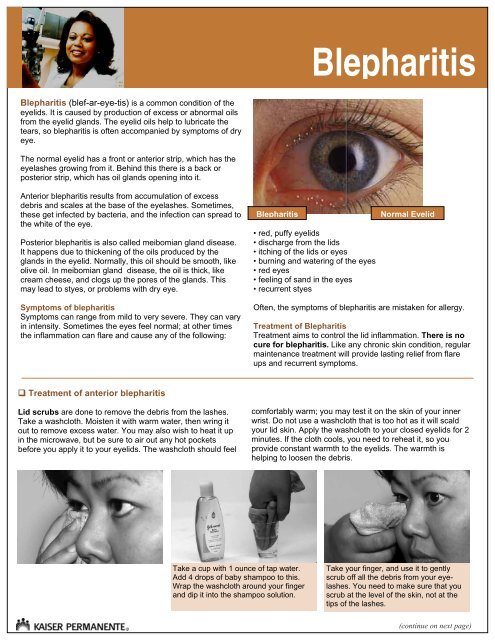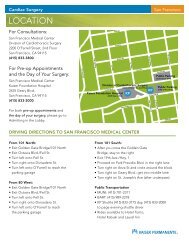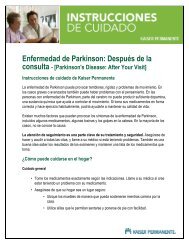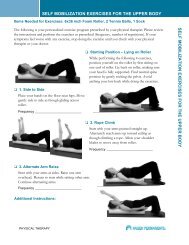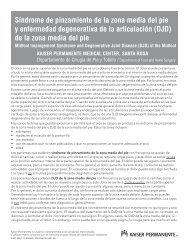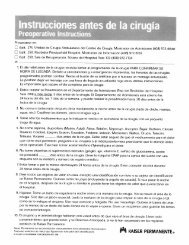Blepharitis Branded V4 2010
Blepharitis Branded V4 2010
Blepharitis Branded V4 2010
Create successful ePaper yourself
Turn your PDF publications into a flip-book with our unique Google optimized e-Paper software.
<strong>Blepharitis</strong> (blef-ar-eye-tis) is a common condition of the<br />
eyelids. It is caused by production of excess or abnormal oils<br />
from the eyelid glands. The eyelid oils help to lubricate the<br />
tears, so blepharitis is often accompanied by symptoms of dry<br />
eye.<br />
The normal eyelid has a front or anterior strip, which has the<br />
eyelashes growing from it. Behind this there is a back or<br />
posterior strip, which has oil glands opening into it.<br />
Anterior blepharitis results from accumulation of excess<br />
debris and scales at the base of the eyelashes. Sometimes,<br />
these get infected by bacteria, and the infection can spread to<br />
the white of the eye.<br />
Posterior blepharitis is also called meibomian gland disease.<br />
It happens due to thickening of the oils produced by the<br />
glands in the eyelid. Normally, this oil should be smooth, like<br />
olive oil. In meibomian gland disease, the oil is thick, like<br />
cream cheese, and clogs up the pores of the glands. This<br />
may lead to styes, or problems with dry eye.<br />
Symptoms of blepharitis<br />
Symptoms can range from mild to very severe. They can vary<br />
in intensity. Sometimes the eyes feel normal; at other times<br />
the inflammation can flare and cause any of the following:<br />
Treatment of anterior blepharitis<br />
Lid scrubs are done to remove the debris from the lashes.<br />
Take a washcloth. Moisten it with warm water, then wring it<br />
out to remove excess water. You may also wish to heat it up<br />
in the microwave, but be sure to air out any hot pockets<br />
before you apply it to your eyelids. The washcloth should feel<br />
Take a cup with 1 ounce of tap water.<br />
Add 4 drops of baby shampoo to this.<br />
Wrap the washcloth around your finger<br />
and dip it into the shampoo solution.<br />
<strong>Blepharitis</strong><br />
<strong>Blepharitis</strong> Normal Eyelid<br />
• red, puffy eyelids<br />
• discharge from the lids<br />
• itching of the lids or eyes<br />
• burning and watering of the eyes<br />
• red eyes<br />
• feeling of sand in the eyes<br />
• recurrent styes<br />
Often, the symptoms of blepharitis are mistaken for allergy.<br />
Treatment of <strong>Blepharitis</strong><br />
Treatment aims to control the lid inflammation. There is no<br />
cure for blepharitis. Like any chronic skin condition, regular<br />
maintenance treatment will provide lasting relief from flare<br />
ups and recurrent symptoms.<br />
comfortably warm; you may test it on the skin of your inner<br />
wrist. Do not use a washcloth that is too hot as it will scald<br />
your lid skin. Apply the washcloth to your closed eyelids for 2<br />
minutes. If the cloth cools, you need to reheat it, so you<br />
provide constant warmth to the eyelids. The warmth is<br />
helping to loosen the debris.<br />
Take your finger, and use it to gently<br />
scrub off all the debris from your eyelashes.<br />
You need to make sure that you<br />
scrub at the level of the skin, not at the<br />
tips of the lashes.<br />
(continue on next page)
Repeat the same procedure on the upper and lower eyelids.<br />
• When your symptoms are worse, do this twice a day. For<br />
long term maintenance, do this once a day, or at least, once<br />
every other day.<br />
Treatment of posterior blepharitis<br />
Lid heat and massage is the mainstay of treatment. The heat<br />
warms up the thick oil and helps it to flow out easily. The<br />
massage directs the loosened oil out of the<br />
clogged pores.<br />
Take a washcloth. Moisten it with warm water, then wring it<br />
out to remove excess water. You may also wish to heat it up<br />
in the microwave, but be sure to air out any hot pockets<br />
before you apply it to your eyelids. The washcloth should feel<br />
comfortably warm; you may test it on the skin of your inner<br />
wrist.<br />
For the lower lid, it helps to look up<br />
while you are doing this.<br />
It is common for the white of your eye to be a little red, and<br />
your vision to be blurred immediately after this.<br />
• Do this warm massage twice a day initially for 2 months. It is<br />
best if you can do this once in the morning, on awakening.<br />
You may also do this in the shower, with warm water directed<br />
to the eyelids for 2 minutes, before you do the massage.<br />
• For long term maintenance, do this once a day at least.<br />
<strong>Blepharitis</strong><br />
• If there is bacterial infection, your doctor may also prescribe<br />
an ointment to apply to the eyelid margins at the end of this<br />
procedure, for a few weeks.<br />
• Rarely, it may be necessary to use oral antibiotics for the<br />
infection.<br />
Do not use a washcloth that is too hot as it will scald your lid<br />
skin. Apply the washcloth to your closed eyelids for 2<br />
minutes. If the cloth cools, you need to reheat it, so you<br />
provide constant warmth to the eyelids.<br />
Use your finger, either with or without the washcloth, to move<br />
across the edge of your eyelid from 1 side to the other,<br />
pressing in at each successive spot firmly, for a few seconds.<br />
For the upper lid, it helps to look down. Do not hesitate to use firm constant<br />
pressure on the lids. This will help to<br />
squeeze the clogged oil out. The pressure<br />
will not harm your eye.<br />
• There are some studies that suggest normalizing the omega<br />
3: 6 ratio in your diet, may help to improve these oils. You will<br />
find these oils in flaxseed, walnuts and fish. Supplements for<br />
omega 3& 6 are also available over the counter. The long<br />
term side effects of these supplements, and the best dose to<br />
be taken is not known.<br />
• If the inflammation is worse, your doctor may prescribe a<br />
course of antibiotics as well. Often, these antibiotics are used<br />
for several months to produce a gradual improvement.<br />
• <strong>Blepharitis</strong> also causes dry eyes. You may also use artificial<br />
tears to improve the lubrication of your eyes.


